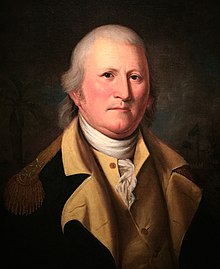William Moultrie | |
|---|---|
 Portrait of William Moultrie by Charles Willson Peale, 1782 | |
| 35th Governor of South Carolina | |
| In office December 5, 1792 – December 17, 1794 | |
| Lieutenant | James Ladson |
| Preceded by | Charles Pinckney |
| Succeeded by | Arnoldus Vanderhorst |
| In office February 11, 1785 – February 20, 1787 | |
| Lieutenant | Charles Drayton |
| Preceded by | Benjamin Guerard |
| Succeeded by | Thomas Pinckney |
| 10th Lieutenant Governor of South Carolina | |
| In office February 16, 1784 – February 11, 1785 | |
| Governor | Benjamin Guerard |
| Preceded by | Richard Beresford |
| Succeeded by | Charles Drayton |
| Personal details | |
| Born | November 23, 1730 Charlestown, Province of South Carolina, British America |
| Died | September 27, 1805 (aged 74) Charleston, South Carolina, U.S. |
| Military service | |
| Allegiance | |
| Branch/service | |
| Years of service | 1761 1775–1783 |
| Rank | Major General |
| Unit | 2nd South Carolina Regiment |
| Battles/wars | |
William Moultrie (/ˈmuːltriː/; November 23, 1730 – September 27, 1805) was an American slaveowning planter and politician who became a general in the American Revolutionary War. As colonel leading a state militia, in 1776 he prevented the British from taking Charleston, and Fort Moultrie was named in his honor.
After independence, Moultrie advanced as a politician; he was elected by the legislature twice within a decade as Governor of South Carolina (1785–1787, 1792–1794), serving two terms. (The state constitution kept power in the hands of the legislature and prohibited governors from serving two terms in succession.)